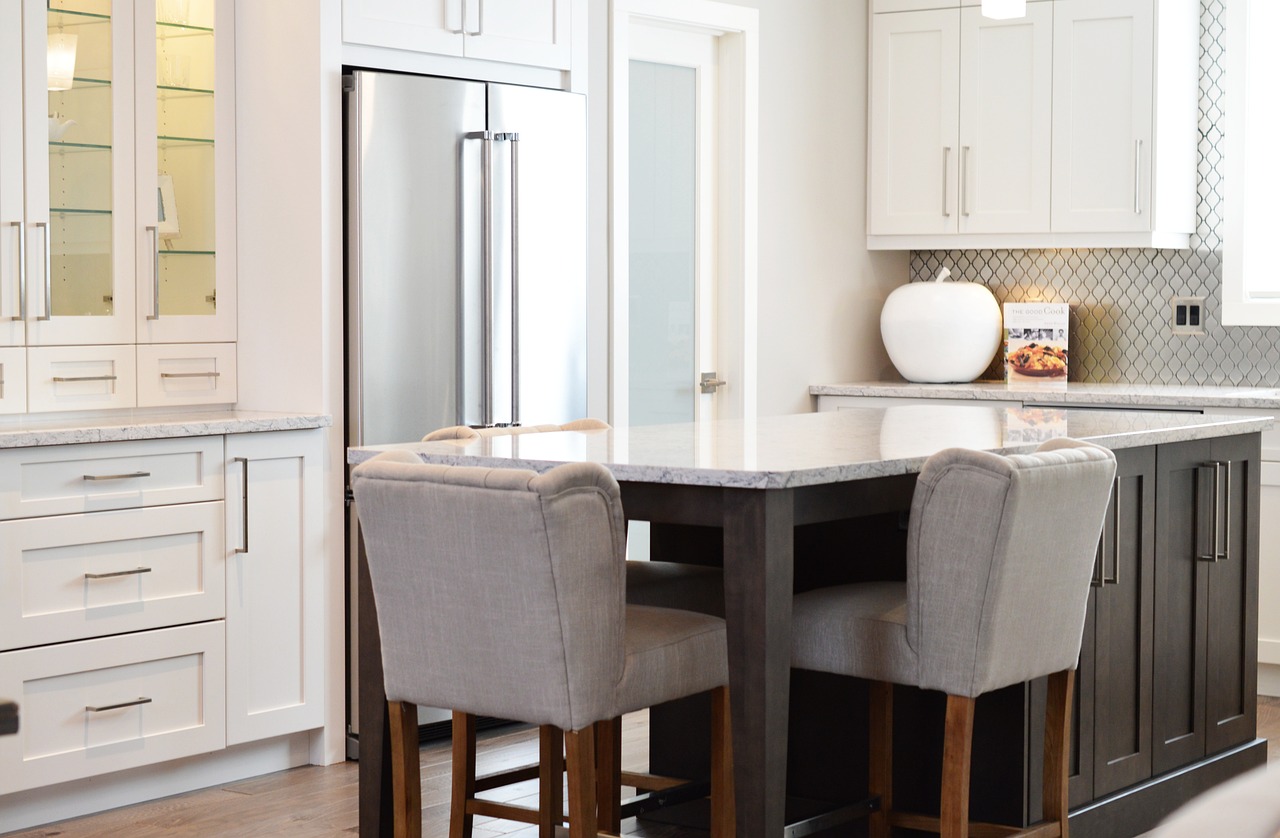Imagine stepping into your kitchen and feeling an instant connection to the sea, with breezy blues, crisp whites, and natural textures evoking the serene beauty of the coast. Whether you live near the ocean or simply want to bring a fresh, coastal vibe into your home, designing a coastal kitchen can create that perfect balance of relaxation and style. In this guide, we’ll explore 21 fresh coastal kitchen design tips that will help you transform your space into a light, airy, and welcoming retreat.
1. Embrace a Soft Color Palette
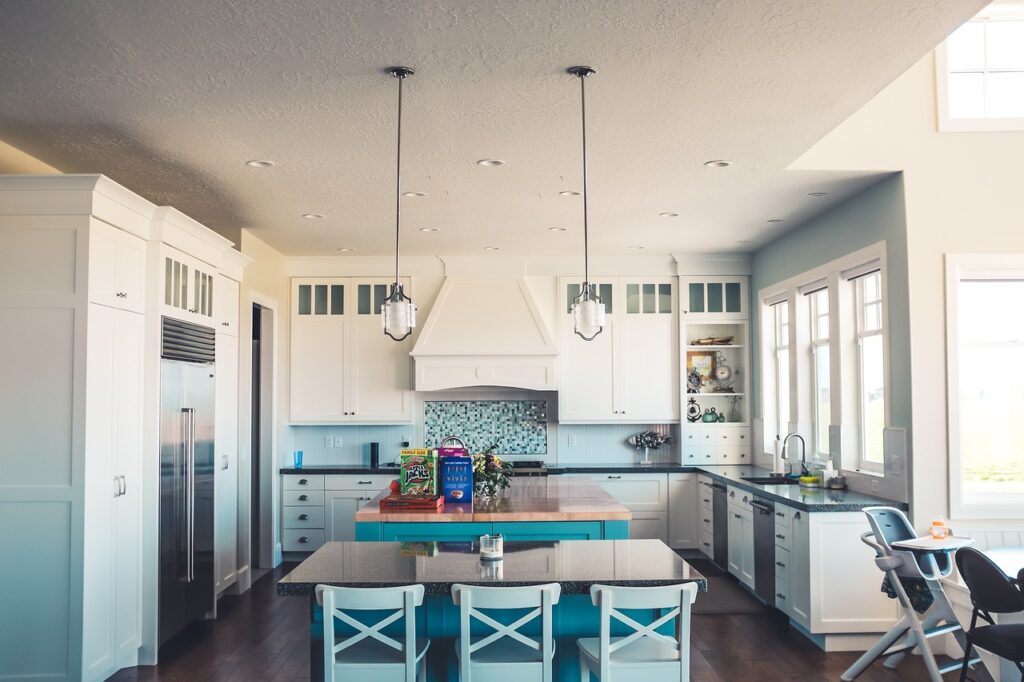
One of the defining characteristics of a coastal kitchen is its soft, soothing color palette. Think of the colors you’d find on a beach—soft blues, warm sandy beiges, and crisp whites. These colors create a calming atmosphere and make your kitchen feel open and airy.
When choosing your color scheme, consider a base of white or light beige for your walls and cabinetry. Add accents of soft blue or aqua through your backsplash, decor, or even your appliances. If you’re feeling bold, a navy blue island can create a striking focal point while maintaining that coastal charm.
2. Use Natural Materials

Natural materials are key to achieving an authentic coastal look. They bring the outdoors in and add a layer of texture that is both visually appealing and tactile. Wood, stone, and rattan are all excellent choices for a coastal kitchen.
For countertops, consider butcher block or a light stone like marble or quartzite. Wooden elements, such as open shelving or a reclaimed wood island, add warmth and character. Rattan or wicker bar stools and chairs reinforce the natural, relaxed vibe. These materials not only look great but also wear well over time, adding to the lived-in, comfortable feel of a coastal kitchen.
3. Incorporate Shiplap Walls

Shiplap walls are a hallmark of coastal design. Originally used in ships, shiplap has become synonymous with coastal and farmhouse styles due to its clean lines and subtle texture. It’s a simple yet effective way to add character to your kitchen.
Consider adding shiplap as an accent wall behind your sink or stove, or use it to panel your kitchen island. You can also use beadboard, a similar material, for a slightly more traditional look. Paint the shiplap white or a light pastel to keep the space bright and airy, or opt for a weathered finish to add a touch of rustic charm.
4. Add Open Shelving
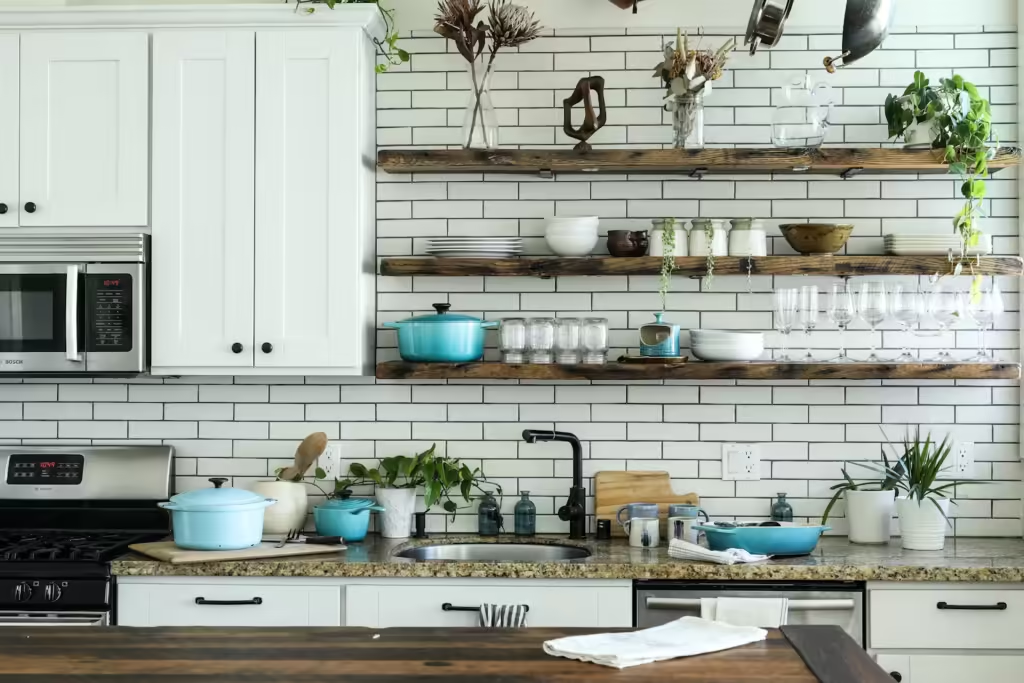
Open shelving is a popular feature in coastal kitchens because it creates an open, airy feel and offers an opportunity to showcase beach-inspired decor. It’s a great way to break up a wall of cabinetry and add a personal touch to your kitchen.
Use open shelves to display items like glass jars filled with seashells or sand, vintage glass bottles, or ceramic bowls in shades of blue and white. You can also use the shelves for everyday items, such as plates and glassware, which are functional yet can add to the aesthetic when chosen in coordinating colors.
5. Choose Light and Breezy Window Treatments
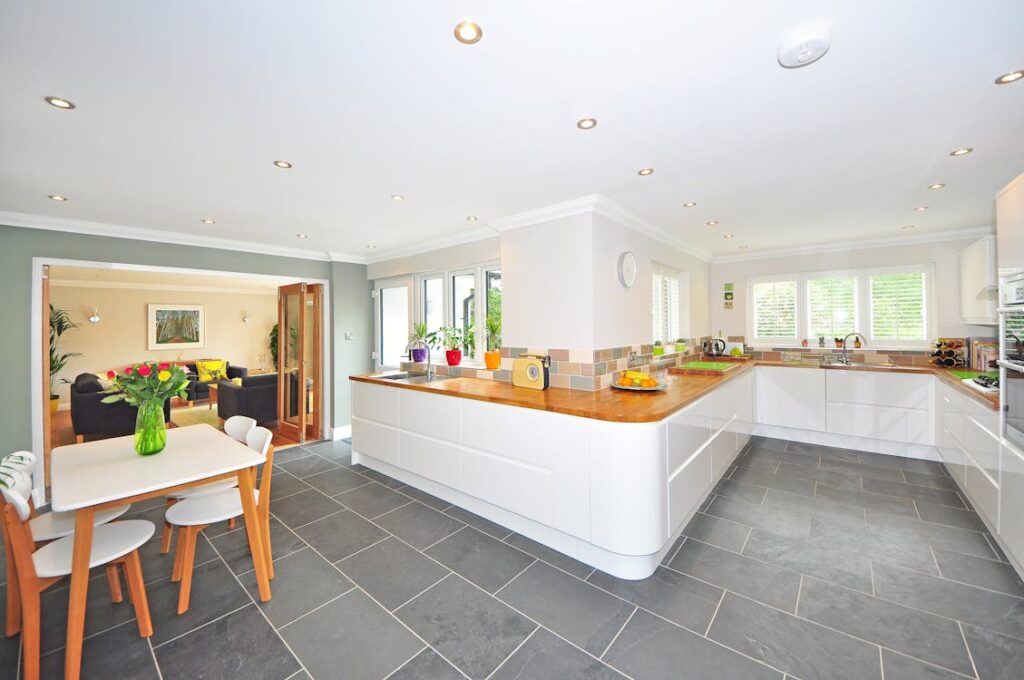
Natural light is essential in a coastal kitchen, so it’s important to choose window treatments that let in as much light as possible while still providing privacy. Light, airy fabrics like linen or cotton work well for this purpose.
Consider sheer curtains that billow with the breeze or simple Roman blinds in a soft, neutral color. Bamboo shades are another excellent option—they add texture and a touch of warmth while still allowing light to filter through. Whatever you choose, keep it simple and understated to let the natural beauty of your windows and the view beyond take center stage.
6. Incorporate Coastal-Themed Decor
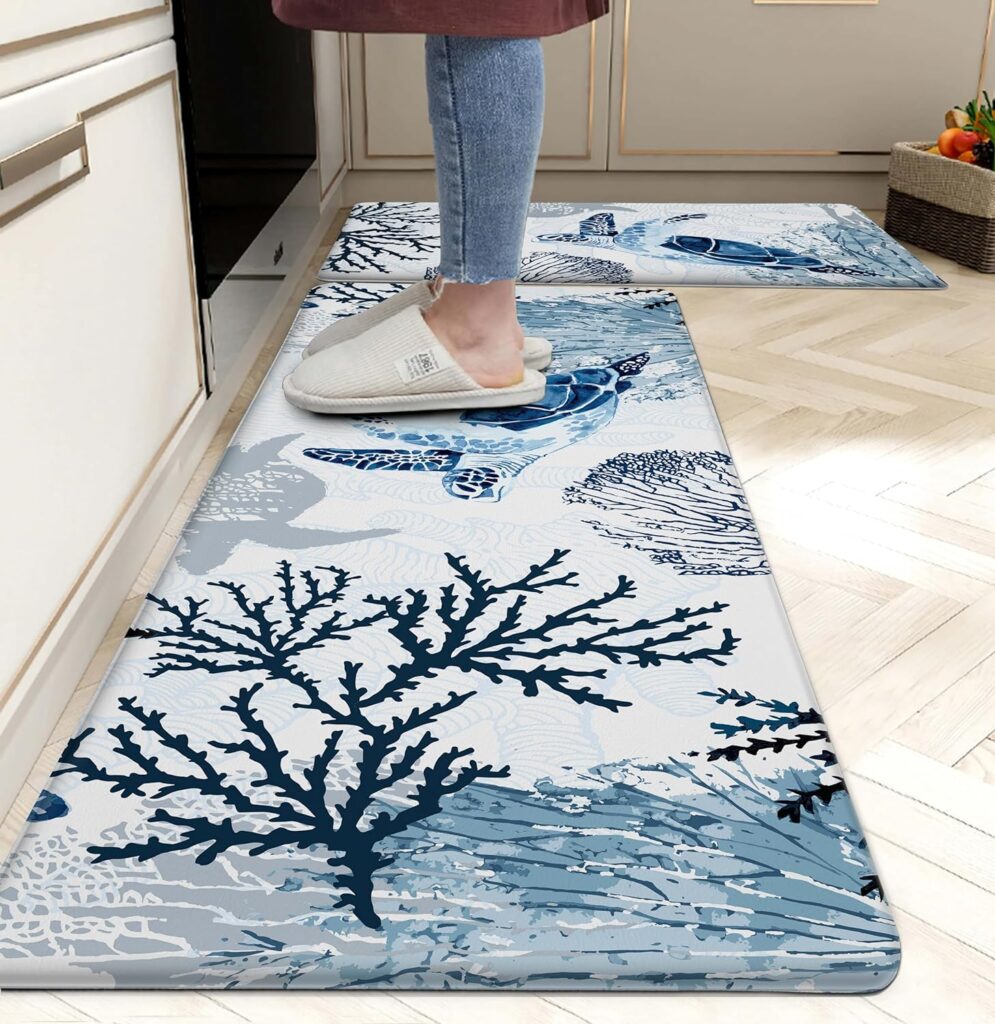
Decor is where you can have fun with your coastal kitchen design, but it’s important to strike the right balance. The goal is to evoke a coastal vibe without going overboard, so think subtle and sophisticated rather than overly themed.
Driftwood sculptures, nautical lanterns, and beach-inspired artwork are all excellent choices. Consider a large, framed photograph of a serene beach scene or a collection of smaller prints featuring marine life or seaside landscapes. You can also add touches of the coast through smaller accessories like shell-shaped dishes, sea glass vases, or a bowl of collected beach pebbles.
7. Use Textured Backsplashes
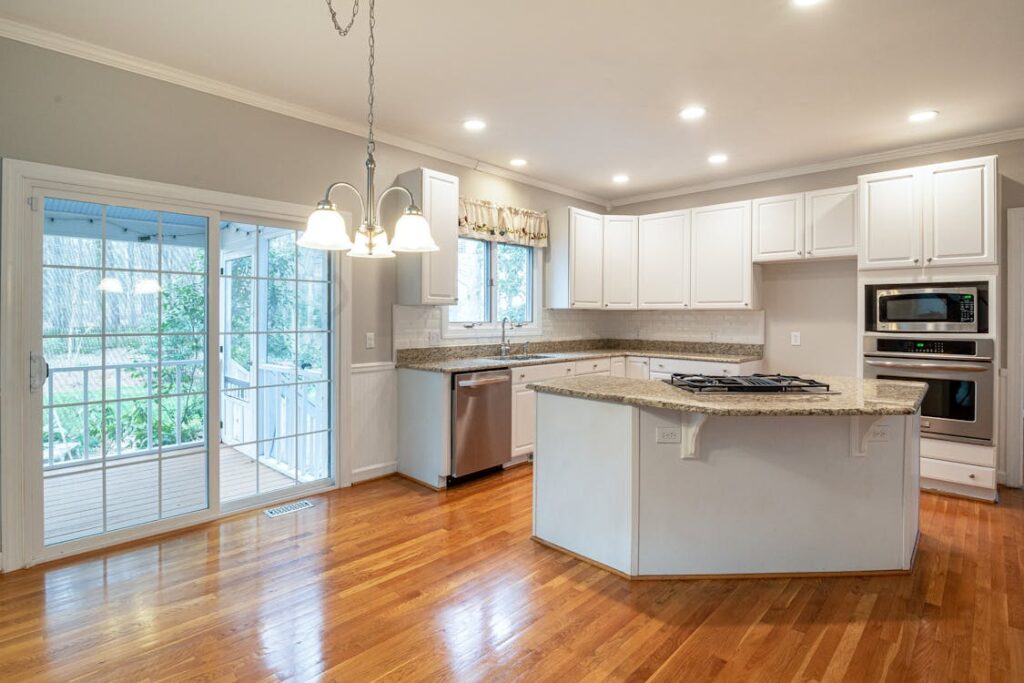
A textured backsplash can add depth and interest to your coastal kitchen. There are many ways to achieve this look, depending on your style and budget. Subway tiles are a classic choice, and their simple, clean lines work well in a coastal setting. For a twist, consider using a beveled or textured subway tile.
Sea glass tiles are another great option—they come in soft, beachy colors and have a subtle sheen that mimics the look of glass washed up on the shore. If you’re looking for something more unique, consider a pebble mosaic backsplash. The natural shapes and textures of the pebbles bring a touch of the outdoors in, adding to the coastal feel.
8. Opt for Nautical Lighting

Lighting plays a crucial role in setting the tone for your kitchen. For a coastal look, consider lighting fixtures that have a nautical or beach-inspired design. Pendant lights are a popular choice for over an island or dining area.
Look for fixtures made from materials like brass, weathered metal, or rope. Lantern-style pendant lights, with their timeless design, evoke a classic coastal feel. Alternatively, consider a chandelier with seashell accents or one made from driftwood for a more unique look. Wall sconces with a similar design can also be used to complement the overall lighting scheme.
9. Go for a Distressed Finish

A distressed or weathered finish on cabinetry or furniture can give your kitchen that lived-in, beachy look that is so characteristic of coastal design. This can be achieved through various techniques, including sanding, staining, or painting.
If you’re up for a DIY project, consider distressing your own cabinets by sanding the edges to reveal a bit of the wood underneath, or applying a glaze for a weathered effect. If you prefer a more polished look, many furniture manufacturers offer pre-distressed pieces. Whitewashed cabinets are another excellent option—they give a clean, bright look while still adding texture and character.
10. Incorporate Blue and White Dishware
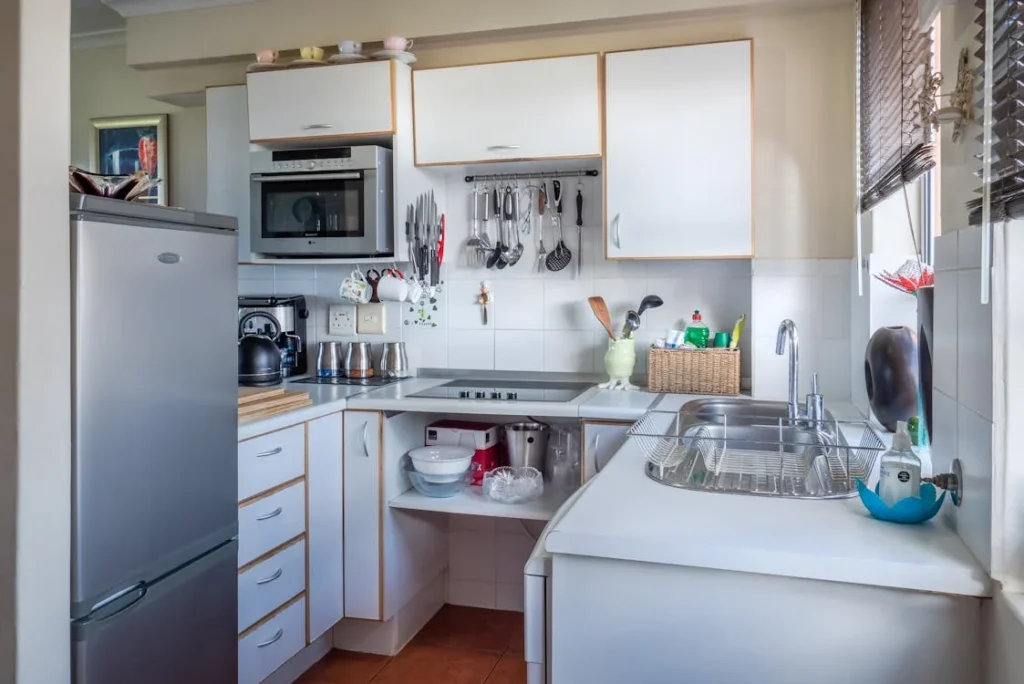
Blue and white is a classic color combination that instantly evokes a coastal feel. One of the easiest ways to incorporate this into your kitchen is through your dishware and kitchen accessories.
Display blue and white plates, bowls, and mugs on open shelves or in glass-front cabinets. Look for pieces with coastal motifs, such as shells, waves, or nautical stripes. You can also add pops of blue and white through kitchen textiles, like dish towels, table runners, or even an apron. This simple addition can go a long way in reinforcing your kitchen’s coastal theme.
11. Include Coastal-Inspired Flooring

Flooring is an often-overlooked aspect of kitchen design, but it can have a significant impact on the overall look and feel of the space. For a coastal kitchen, consider flooring options that mimic the natural elements of the beach.
Weathered wood or bleached oak flooring is a popular choice for its rustic, laid-back vibe. If you prefer a more durable option, luxury vinyl plank flooring can offer the look of wood with added resilience against spills and moisture. Another option is to incorporate natural fiber rugs, like seagrass or jute, which add warmth and texture to the space.
12. Create a Coastal-Inspired Backsplash Mural

For a truly unique focal point, consider creating a backsplash mural that depicts a coastal scene. This can be done with custom tiles or by commissioning a hand-painted mural.
A backsplash mural can depict anything from ocean waves to coral reefs, or even a serene sunset over the water. This is an excellent way to personalize your kitchen and create a standout feature that will draw the eye. If a full mural feels too bold, consider using accent tiles with coastal motifs interspersed throughout a more neutral backsplash.
13. Opt for White or Light-Colored Cabinetry
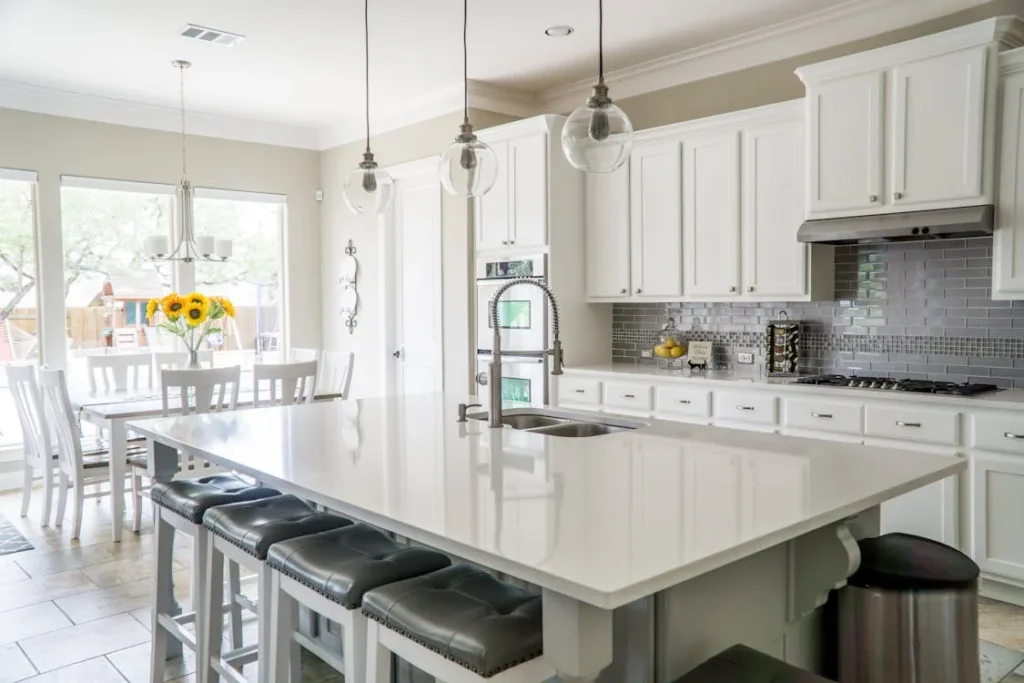
White cabinetry is a staple in coastal kitchens because it creates a clean, bright, and timeless look. It also serves as the perfect backdrop for other coastal elements, such as blue accents or natural materials.
If all-white cabinets feel too stark, consider mixing white upper cabinets with a contrasting island or lower cabinets in a soft blue or gray. You can also add warmth by incorporating wood accents, such as wooden cabinet pulls or a wooden range hood. The key is to keep the overall look light and airy, which is essential to the coastal aesthetic.
14. Add Coastal-Inspired Bar Stools
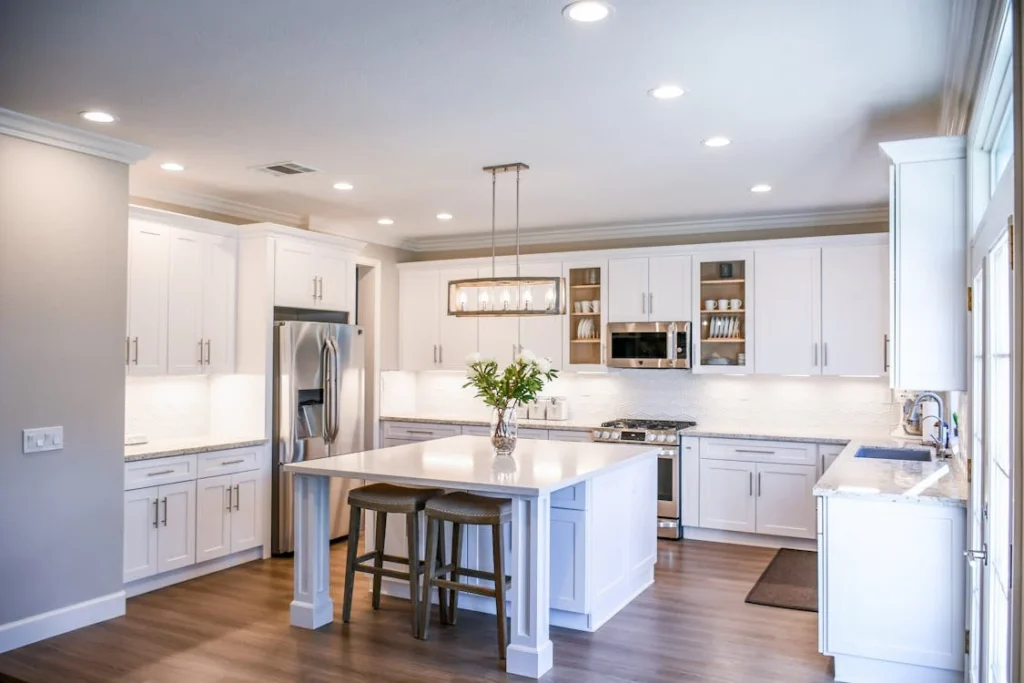
Bar stools are a great way to reinforce the coastal theme in your kitchen, especially if you have an island or breakfast bar. Look for stools made from natural materials like wicker, rattan, or weathered wood.
You can also add cushions or upholstery in coastal colors or patterns, such as blue and white stripes or a subtle nautical print. The right bar stools can not only enhance the overall design of your kitchen but also provide a comfortable spot for casual dining or socializing.
15. Integrate Sea Glass Elements

Sea glass is a beautiful and versatile material that can be used in a variety of ways to add a touch of the coast to your kitchen. Its soft, frosted finish and ocean-inspired colors make it a natural choice for coastal decor.
Consider using sea glass cabinet pulls or knobs to add a subtle touch of color and texture. You can also incorporate sea glass into your lighting fixtures, such as pendant lights or chandeliers. For a more decorative touch, fill a glass bowl with pieces of sea glass and display it on your countertop or open shelving.
16. Incorporate Woven Textures

Woven textures are a must-have in any coastal kitchen, as they add warmth and a natural element that complements the overall design. Rattan, wicker, and seagrass are all excellent choices for adding texture to your space.
Incorporate these materials through woven baskets for storage, rattan chairs or bar stools, or wicker pendant lights. A woven texture can also be added through textiles, such as placemats, table runners, or even a woven rug. These elements help to create a cozy, inviting atmosphere that is perfect for a coastal kitchen.
17. Use Beach-Inspired Art
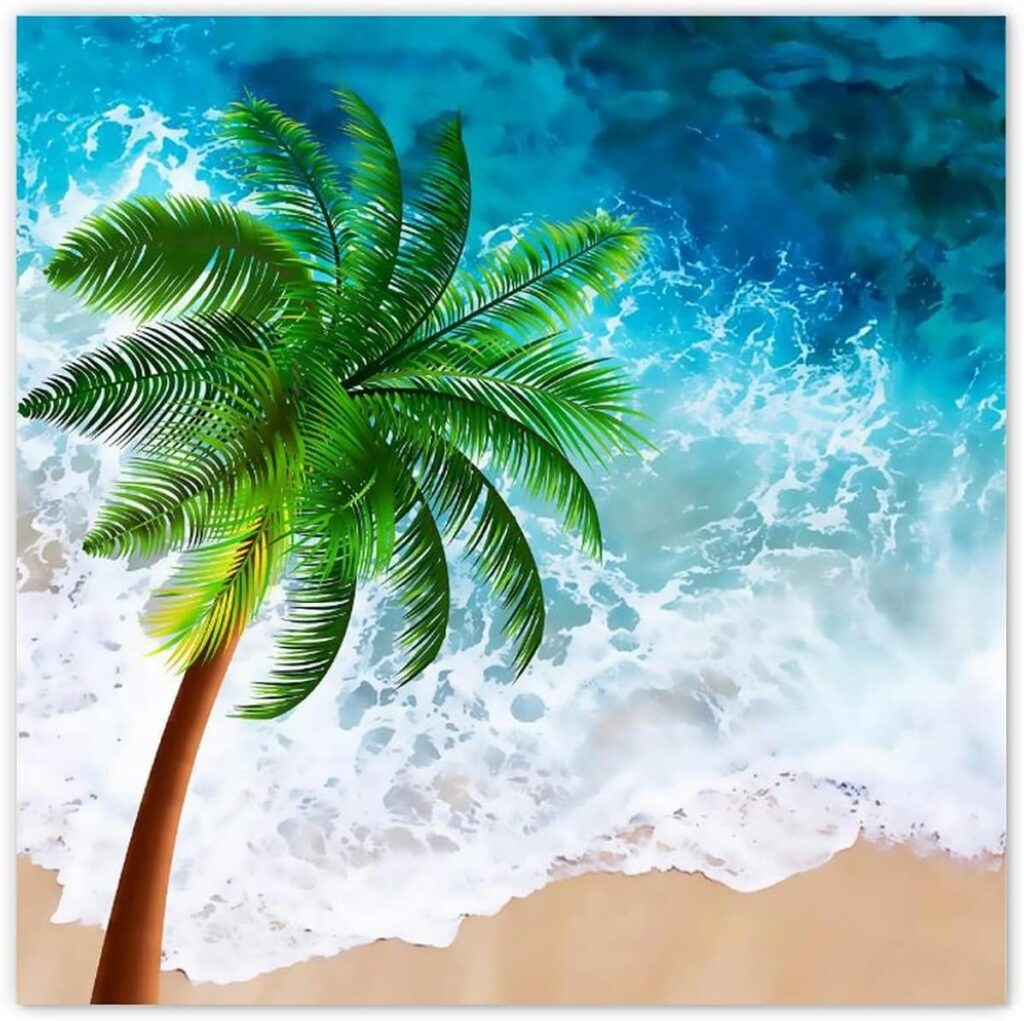
Art is a powerful tool in creating a coastal vibe in your kitchen. Beach-inspired art can range from serene ocean landscapes to playful depictions of coastal wildlife, such as seagulls or crabs.
Consider creating a gallery wall with a collection of smaller pieces, or opt for one large, statement piece above your dining table or kitchen island. Choose artwork that features soft, muted colors to keep the look cohesive and calming. Framing your artwork in white or light wood frames will further enhance the coastal aesthetic.
18. Install a Farmhouse Sink

A farmhouse sink, also known as an apron-front sink, is a popular choice in coastal kitchens due to its blend of practicality and style. These sinks are not only functional, providing plenty of space for washing dishes, but they also add a charming, vintage feel to your kitchen.
Pair a white porcelain farmhouse sink with a brass or nickel faucet for a classic look. If you prefer a more contemporary style, consider a stainless steel or copper farmhouse sink. The key is to choose a sink that complements the other elements of your kitchen while adding to the overall coastal vibe.
19. Bring in Greenery
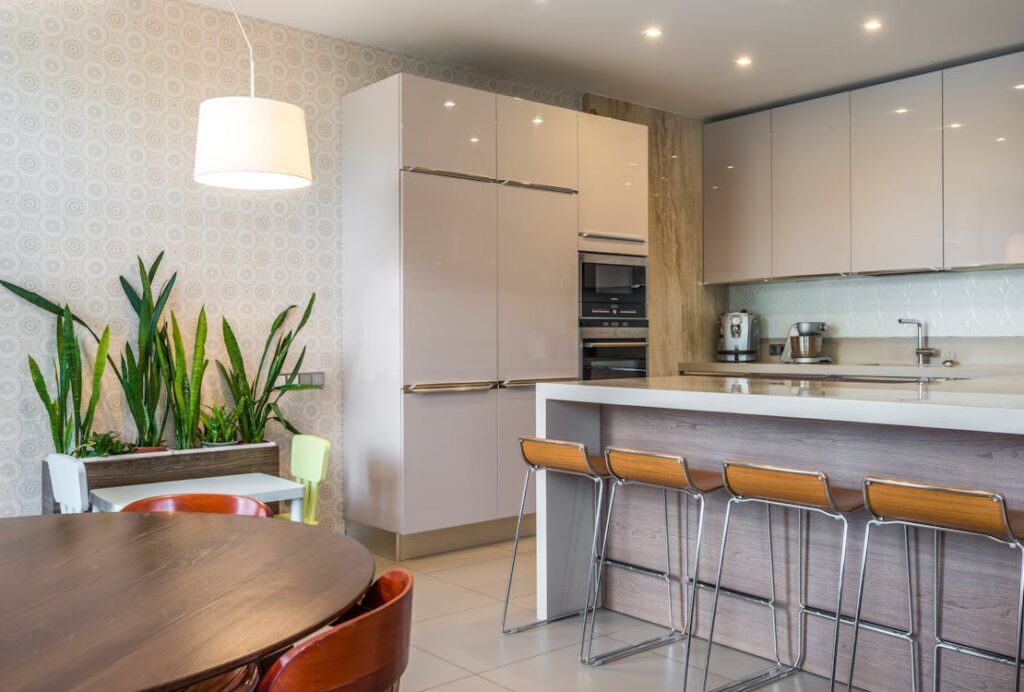
No coastal kitchen is complete without a touch of greenery. Plants not only add life and color to your space but also help to purify the air and create a more inviting atmosphere.
Consider adding potted herbs to your windowsill or countertop—basil, rosemary, and thyme are all excellent choices that are both decorative and useful in cooking. For a larger statement, place a potted palm or fern in a corner of your kitchen. If you prefer low-maintenance options, succulents or air plants are great choices that require minimal care.
20. Utilize Weathered or Reclaimed Wood

Weathered or reclaimed wood is a key element in coastal design, adding character and a sense of history to your kitchen. This material can be used in a variety of ways, from countertops and shelving to decorative beams or even flooring.
Reclaimed wood has a unique, rustic appeal that can’t be replicated with new materials. It often has a weathered patina and may include knots, nail holes, or other imperfections that add to its charm. If reclaimed wood isn’t available, you can achieve a similar look with weathered wood finishes or by using wood that has been treated to mimic the effects of exposure to the elements.
21. Incorporate Nautical Stripes
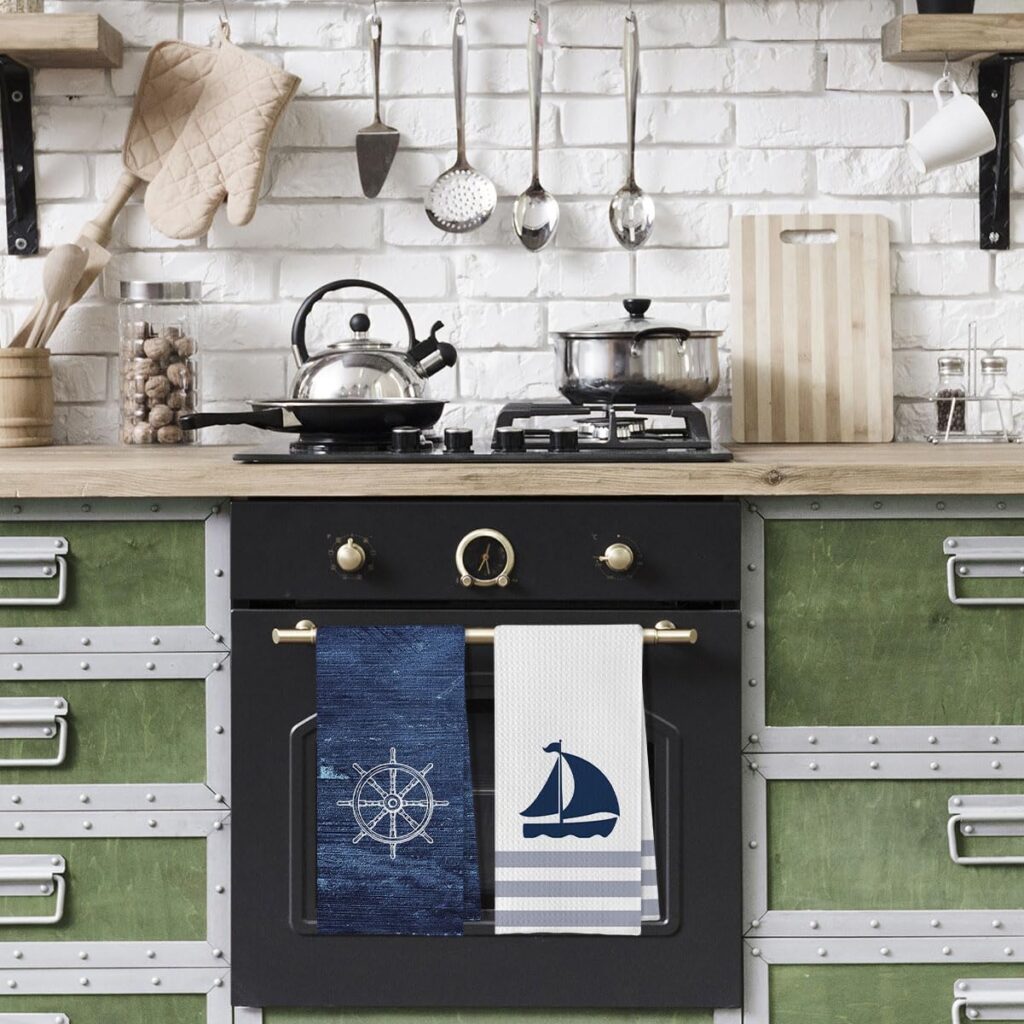
Nautical stripes are a classic element of coastal design, evoking images of sailors’ uniforms and beach umbrellas. They can be incorporated into your kitchen in a variety of ways, adding a touch of the coast without overwhelming the space.
Consider using striped cushions on your bar stools, a striped rug in front of your sink, or even striped dish towels hanging from your oven handle. The key is to use stripes sparingly and pair them with solid colors to avoid creating a busy or cluttered look. Stick to traditional nautical colors like navy and white, or try softer hues like light blue and cream for a more subtle effect.
Wrap Up
By blending natural textures, coastal hues, and beach-inspired details, you can transform your kitchen into a fresh and inviting space that captures the beauty of the coast. These 21 design tips offer endless inspiration for creating a coastal kitchen that’s perfect for everyday living and entertaining. No matter your style, adding a touch of coastal charm will bring a refreshing and timeless appeal to your home.

